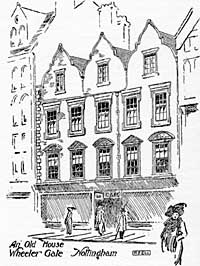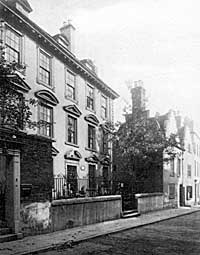
An old house on Wheeler Gate.
If not equal in importance to Bath, Epsom and Tunbridge Wells, this dear old town must have been a delightful place to dwell in with its numerous “mansions of the nobility”—the Pierreponts (Stoney Street), Plumtres (St. Mary’s Hill), Gregorys (Fletcher Gate), Parsons (Short Hill), Babyngtons (Cheapside), Willoughbys (Low Pavement), Howes (Castle Gate),and the comfortable homes of civic dignitaries situate amid sylvan surroundings—beautiful gardens and fields on the one side and verdant meadows and the Duke’s park1 on the other wherein the fallow-deer roamed at large.
Well may Dr. Deering write in his History2 “the Towns of considerable Business and a flourishing Trade seldom give Gentlemen great Encouragement to be found in settling in them, yet this must be said for our Town that the healthful air, the pleasant Site, and the plenty of all sorts of necessaries, as well as Conveniences of Life, maugre all other Objections has even very lately induced some Gentlemen to build themselves Mansion Houses in it.”
Some of these houses are now difficult to locate. Records only refer to the name of the occupants, as everyone at that time was supposed to know where everyone else lived. The system of street numbering, adopted in Paris as long ago as 1512, was not introduced into Nottingham until the dawn of the 19th century.3
Foremost amongst those who selected Nottingham as a place of residence was William Cavendish, first Duke of Newcastle, one of the most prominent noblemen of the time, and perhaps this may be cited as an additional reason why the town became so popular. The ducal mansion was built upon the ruins of the mediaeval castle. It was commenced in 1674, and completed five years later by the second duke. The principal rooms are on the first floor above a plain basement storey, containing the domestic offices. The main entrance was in the centre of the east front approached by a broad double flight of steps (now removed). The windows on the principal floor are dressed with architraves and pediments of alternate design, while the windows above are set in squares and surrounded with scroll-work of a somewhat peculiar design. The façade is divided into bays by attached columns after the Corinthian order, and finished with a bold cornice and parapet. The whole fabric is faced with Castle Donington stone set in large blocks with rebated joints. An equestrian statue of the first duke, who was an accomplished horseman, was placed above the entrance, and his garter, crests, and other insignia of titles and dignities are displayed in conspicuous positions about the façade.
This classical style of building was an innovation, in marked contrast with the work of the previous century, when shaped gables after the Dutch manner were predominant. Until a few years ago several brick houses, having cut and shaped gables, were to be seen in Nottingham, but the only’ good example now remaining is a house near the top of Wheelergate on the west side.4
I can find no authentic record as to the original ownership or date of erection of this house. It is claimed by some authorities to be the “Feathers Tavern” whither Lord Delamere5 repaired in November, 1681, in order to confer with the nobility during the Revolutionary period, but this does not seem likely when we consider the facts.
Blackner says “The Feathers Inn is now (1815) a private house and stands near the top, and on the west side of Wheelergate” (p. 378). He also informs us that the Town Hall of the French Borough stood until 1714 on the site where now stands the house of Alderman Ashwell at the N.W. corner of Wheelergate. According to Deering and other writers “the Feathers stood at the corner of Fryer Lane on the spot where the Town Hall of the French Borough formerly stood” (hence the terms Moot Hall and Moot Ha11 Gate, used in old leases, &c.) It would appear that the confusion has arisen from the words “near the top” having been used interchangeably with “at the corner of” Wheelergate, together with the fact that the buildings were similar in appearance, each block comprising three shaped and moulded gables. The Town Hall of the French Borough was replaced by the Feathers Inn, this in turn gave place to a private house, which eventually was changed to the Moot Hall Vaults, the predecessor of the modern structure which now occupies the site.
The house we are considering near the top of Wheelergate is now given up entirely to business pursuits; and while this has taken away some of its interest, it has not robbed it of all its old-time dignity and importance. Judging by the style of architecture, the shaped and moulded gables, the heavy stone architraves6 and pediments to the windows, the stone quoins at the angles, and the elaborate plaster enrichment to the ceiling of the principal room, I am of opinion that this building was erected during the reign of Charles II., to serve as the town-house of a gentleman. I can well remember the demolition of the old Water Offices—the adjoining building on the south—when sufficient evidence was disclosed, to shew that this house was built in between older premises. It is doubtless one of the first of the mansions that were “built soon after the Restoration,” and tradition may be right in ascribing it to Lord Mansfield.
This building is worthy of careful study as an example in transition from the earlier type with gables to the later type with horizontal cornice. It should also be noticed that the topmost windows on the front are casements in accordance with the older style, while the lower windows are sliding sashes after the newer style. The sliding sash, however, must not be taken as an infallible indication of the date of erection; for it was not unusual for old houses to be re-sashed in whole or part, to bring them up to date, in this respect.

Newdigate House, Castle Gate.
Newdigate House, in Castle Gate—known also as Marshal Tallard’s house, from the fact that the French General lived there on parole, after his defeat by the Duke of Marlborough at the battle of Blenheim in 1704—was built a little later in time, than the house last described. Its probable date is 1675, and the house is therefore coeval with the ducal mansion, which it resembles in a humbler degree. The shaped gables of the earlier period have given place to dormers on the roof, above an overhanging eaves-cornice composed of carved modillions with panelled soffits between; the architraves to the upper windows are carried all round, and form a complete frame with a carved patena in each corner; the lower windows are treated in the usual way with heavy stone architraves and pediments, and the main angles are emphasized with projecting stone quoins. The walls are built of bricks (101/2in. x 21/2in), but the external faces are covered with stucco and painted in imitation of stone. There is a fine stretch of ornamental wrought-iron railing in front of the house (illustrated and described in Vol. XI., 1907, page 112). The contrast between the classical façade and the gabled brickwork of a former period, as exemplified in the small house adjoining, is very noticeable in the illustration.
(1) Discontinued as a deer park 1720.
(2) Deering’s History of Nottingham. Section I., p. 6.
(3) Willoughby’s Directory, 1799, does not give any numbers.
(4) The Old Grammar School at Bulwell still remains, but the “White Horse “Inn, at Radford, erected 1661, has been pulled down and rebuilt this year. See Transactions for illustrations, Vol. XI., 1907.
(5) “Lord Delamere was quartered at the Feathers; the Duke of Devonshire, Earl of Stamford, Lord Howe and many other nobles came to meet with him.” Deering, p. 121.
(6) Comparing a list of trades in 1641 with facts when writing in 1751, Deering notes (p. 96) that whereas there were eleven bricklayers now and none then, three masons then and only one now “because it was then newly come into Fashion to have Stone Window Frames, or else Bricklayers. who very likely worked both in Brick and Stone, as they now in this Town all do.”
